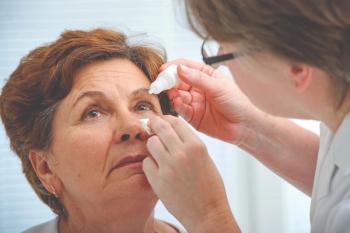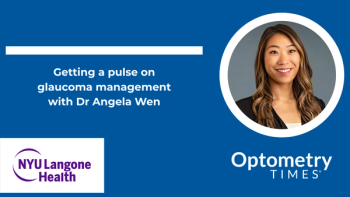
Details matter when prescribing meso-zeaxanthin
Recently, there has been interest by pediatric ophthalmology in protecting our most valuable retinal real estate, the fovea, with dietary zeaxanthin
The ratio of lutein to zeaxanthin to meso-zeaxanthin in human serum is 3:1:0, and the U.S. dietary ratio is 5:2:0; the latter proportion is incorporated in AREDS II science.1 The science behind lutein is widely recognized.2
Recently, there has been interest by pediatric ophthalmology in protecting our most valuable retinal real estate, the fovea, with dietary zeaxanthin. It is abundant in breast milk and associated with infant foveal development to age 4.3 High concentrations of dietary zeaxanthin have been shown to reduce the number of anti-vascular endothelial growth factor (VEGF) injection treatment cycles by nearly 25 percent.4
Related:
Examining a meta-analysis
Surprisingly, a recent Chinese meta-analysis study evaluating the three retinal carotenoids purports to solidify the notion that despite the magnitude of the published evidence on the two dietary carotenoids (lutein and zeaxanthin), three retinal carotenoids are required for foveal health.5 The authors analyzed 20 studies, including a lutein study from our medical center, and four which utilized the marigold lutein derived supplement meso-zeaxanthin (MZ) produced by Industrial Orgánica S.A. de C.V. in Mexico.6
Although their meta-analysis inclusion criteria specified only randomized controlled trials, only two of the four MZ studies selected fell into that category.
Nevertheless, three of their conclusions are supported:
• Oral supplement compositions containing lutein and zeaxanthin address increased macular pigment optical density (MPOD) values
• A dose-response relationship exists between carotenoid intake and the increase in MPOD
• There is an improved effect upon MPOD when supplementation is continued for longer than 12 months
Related:
However, there is no evidence whatsoever for the statement that “This meta-analysis revealed that lutein, zeaxanthin, and meso-zeaxanthin supplementation improved MPOD both in age-related macular degeneration (AMD) patients and healthy subjects.” None of the four cited MZ studies evaluated subjects with AMD.
Supplement usage
The differences in the supplements used in the studies (carotenoid source, product composition, and formulation ratio) differed markedly within the 20 studies. Some of the studies used a specific brand of un-esterified (“free”) lutein (alone or in combination with added zeaxanthin; seven studies) while the remaining studies used different forms of lutein, including lutein esters from marigold or lutein extracted from kale-each in the form of capsules, tablets or soft gels.
Related:
All of these details affect both bioavailability and MPOD.
The MPOD measurement technology, equipment, and angular measurement eccentricities were also different (i.e., heterochromic flicker photometry [HFP], autofluorescence, fundus reflectometry) in the 16 non-MZ studies. However, they were the same in the four MZ studies. The effect that the composite of these differences might have upon the outcome is impossible to estimate.7
Comparing study values
Finally, there are discrepancies in the “weighted mean value” of two studies.
The Garcia-Layana study assessing the effect of lutein supplementation was reported to show a decrease in MPOD of 0.1 density units, while in reality the original paper reports an increase in MPOD of the same magnitude.8
The bone study supplementing lutein, zeaxanthin, and MZ is reported to induce a significant increase in MPOD, while the number in the original publication seems to indicate a substantially lower value.9
Related:
The totality of discrepancies outlined above may substantially impact the conclusions of this meta-analysis. Therefore, the statement “a greater increase in MPOD was observed in trials combined with meso-zeaxanthin in comparison with those without meso-zeaxanthin” deserves careful further evaluation.
The impact of different ratios of lutein:zeaxanthin:MZ upon non-ocular tissues such as the brain (a lutein and zeaxanthin target organ)is also of concern when using non–dietary carotenoids or non-physiologic–based serum percentages.10
Clinical formulations advocated for the developing infant visual system or for protection of seniors with AMD deserve scientific scrutiny.
Related:
References
1.Age-Related Eye Disease Study 2 (AREDS2) Research Group, et al. Secondary analyses of the effects of lutein/zeaxanthin on age-related macular degeneration progression: AREDS2 report No. 3. JAMA Ophthalmol. 2014 Feb;132(2):142-9.
2. Kijlstra A, Tian Y, Kelly ER, Berendschot TT. Lutein: more than just a filter for blue light. Prog Retin Eye Res. 2012 Jul;31(4):303-15.
3. Henriksen BS, Chan G, Hoffman RO, Sharifzadeh M, Ermakov IV, Gellermann W, Bernstein PS. Interrelationships between maternal carotenoid status and newborn infant macular pigment optical density and carotenoid status. Invest Ophthalmol Vis Sci. 2013 Aug 15;54(8):5568-78.
4. Olk J, Peralta E, Gierhart D, Brown G, Brown M. Triple combination therapy and zeaxanthin for the treatment of neovascular age-related macular degeneration: an interventional comparative study and cost-effectiveness analysis. International Journal of Retina and Vitreous. Nov 15. 20151:22
5. Ma L, Liu R, Du JH, Liu T, Wu SS, Liu XH. Lutein, zeaxanthin and meso-zeaxanthin supplementation associated with macular pigment optical density. Nutrients. Jul 16;8(7). pii: E426.
6. Richer S, J Devenport J and Lang J. LAST II: Differential temporal responses of macular pigment optical density (MPOD) in patients with atrophic ARMD to dietary supplementation with xanthophylls: in review. Optometry. May 07; 78(5), 213-9.
7. Crosby-Nwaobi R, Hykin P, Peto T, Sivaprasad S. An exploratory study evaluating the effects of macular carotenoid supplementation in various retinal diseases. Clin Ophthalmol. May 16; 11;10:835-44.
8. GarcÃa-Layana A, Recalde S, Alaman, AS, Robredo PF. Effects of lutein and docosahexaenoic Acid supplementation on macular pigment optical density in a randomized controlled trial. Nutrients. Feb 13; 5(2): 543-551.
9. Bone R, Landrum JT, Cao Y, Howard AN, Alvarez-Calderon F. Macular pigment response to a supplement containing meso-zeaxanthin, lutein and zeaxanthin. Nutr Metab (Lond). 2007 May 11, 4:12.
10. Vishwanathan R, Schalch W, Johnson EJ. Macular pigment carotenoids in the retina and occipital cortex are related in humans. Nutr Neurosci. 2016; 19(3):95-101.
Newsletter
Want more insights like this? Subscribe to Optometry Times and get clinical pearls and practice tips delivered straight to your inbox.



















































.png)


